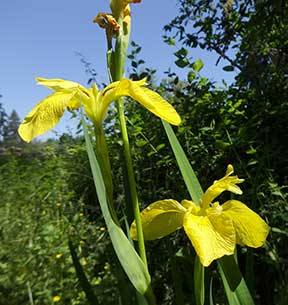 |
Previous Issues |
| Cedar Mill Community Website |
|
Search the Cedar Mill News: |
About The Cedar Mill News |
|
|||||||
| Volume 14, Issue 5 | May 2016 |
||||||
Invasive Plants: Nature’s Femmes Fatales
|
|||
 |
Walking alongside an Oregon stream, you might encounter a tall stand of butter-yellow irises rising from the water. You may gasp at the beauty of this flower and the drama of the flowers against their chartreuse, sword-shaped leaves. Sadly, you are witnessing a hostile takeover. Yellow flag iris (Iris psuedocorus) is an invasive species. It grows rapidly, steals the resources of its native neighbors, and sickens livestock. Like many other noxious weeds, its beauty can blind us to the harm it can do to our native habitats.
English ivy (Hedera helix), purple loosestrife (Lythrum salicaria), butterfly bush (Buddleja davidii): the list of troublesome beauties goes on and on. How is it that so many invasive plants are also so lovely to look at? Most invasive species were brought to the United States in one of three ways: accidentally (e.g., imported through goods or in the ballast water of ships), for utilitarian purposes (e.g., for food sources or biocontrol), or for ornamental use (e.g., in gardens or for cut flowers).
Early settlers from Europe brought many of these plants simply because they were pretty. In the centuries since, many of these ornamental imports have escaped gardens and farms. Lacking natural predators, these plants can become noxious weeds, crowding out native species, altering soil and water composition, and damaging ecosystems.
So what’s a well-meaning gardener to do? How can you be sure you aren’t planting invasives, especially when some of them are still sold in nurseries and online?
Learn to identify them by sight. You can attend a Weed Watcher training this spring, or train yourself using our resources online.
Look for tell-tale characteristics. Be suspicious of plants that are self-sowing, fast-spreading or very low-maintenance.
Go native! Many gorgeous alternatives are indigenous to the Pacific Northwest, so you won’t have to forgo beauty in your garden in order to “go native.” Visit the Native Plants for Willamette Valley Yards guide for ideas.
Shop local! It’s the heart of native plant sale season here in Washington County. Find the right plant for your place at one of these local fundraisers.
![]()
Like us on Facebook for timely updates
Published monthly by Pioneer Marketing & Design
Publisher/Editor:Virginia Bruce
info@cedarmillnews.com
PO Box 91061
Portland, Oregon 97291
© 2016